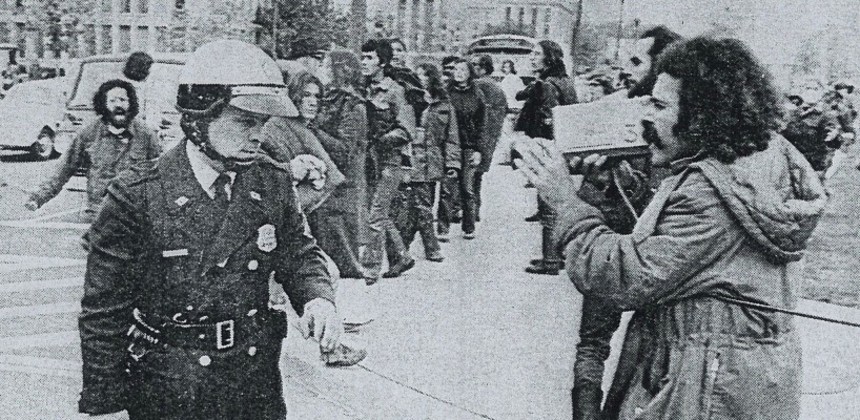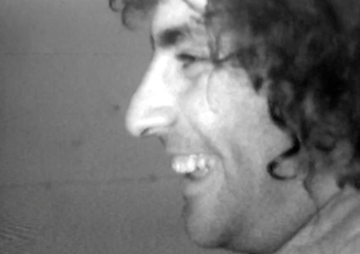Review: HERE COME THE VIDEOFREEX Looks Back, On Tape

Or: How a Bunch of Dirty Hippies Stole Television, and Almost Got Away with it.
In the late 1960s, TV news field reporting was still shot on film. This required all manner of kowtowing to the format's sensitivities: light tight changing bags, carrying umpteen reels of unexposed (and exposed) stock, ten minute limitations, and constant lighting concerns. Technological progress had been made in the years leading up to the widespread turbulence of the era, but these issues remained, and as far as shooting on film is concerned, they still do.
Video, on the other hand, was (and still is) an altogether different media platform. What's sacrificed in terms of cinematic richness of image is compensated for in sheer ease of use. Back then, it was brand new. Not many people had their hands on video cameras yet, but the stark, you-are-there quality of the magnetic-based technology was something entirely fresh.

Simultaneously, the world was erupting. The political and social heat was on, with issues of race, gender, and Vietnam fueling the boil. Amid the turmoil, a young collective of east coast longhaired activists and activist types, united through a common interest in video documentation, came together to get it on tape. Woodstock. Abbie Hoffman and the war protesting. Fred Hampton and the Black Panther movement. The evolving battle for women's equality. All of it, obsessively chronicled by this motley crew of hirsute journalists. They called themselves "the Videofreex".
The documentary Here Come the Videofreex tells their story. Assembled from a solid foundation of the meticulously restored original greyscale tapes, the compact film hops from highlight to highlight with contemporary interviews with the surviving participants.
Born of a humble but successful Kickstarter campaign, Videofreex bears all the evidence of being a labor of love for its filmmakers, Jon Nealon and Jenny Raskin. No doubt compelled by the treasure trove of archival footage, the film attempts to get at a parallel inherent in the Videofreex' grassroots journalism and today's world of viewer submitted iPhone footage making up the nightly news. The collective is cited for being at the vanguard of such "democratization" of reporting, a credit actualized in the telling of their association with the establishment behemoth CBS News.
Looking to find a fresh approach to covering the emerging counter culture and all of its wave-making, CBS News rolled the dice by throwing in with this group; their long hair, video cameras, and their idealism.
This did not go well. Strident, protective, and perhaps a bit entitled, the Videofreex balked, then mutinied when the network moved to alter one of their biggest stories, the life and death of murdered African-American activist Fred Hampton. The disgraced CBS executive who lost his job over the incident is interviewed for the film, his pain still palpable. As for the Videofreex, they took to the hills. With no outlet for their ever-expanding wealth of footage (even then, video compulsion was a thing), they resorted to launching a pirate TV channel in the mountains of upstate New York. It is here, right as their technology of choice is taking hold and their lifestyle is becoming passé, that their story fizzles out.
Here Comes the Videofreex is a must-see for anyone interested in the American civil rights movement of the late 1960s, how it was covered by the mainstream media of the time, and the rise of video technology alongside of it all. That said, the film itself lacks the teeth of its subject matter. Unlike the similarly set documentary Best of Enemies, Videofreex lacks both that film's perceived effortlessness at connecting then to now, as well as its ability to truly engage viewers not already on board with its topics. Somewhere in this material lies a sharper edge just waiting to cut more deeply.
That said, the film should not be dismissed. Although, yes, it could be better, Here Come the Videofreex is a perfectly respectable effort that draws from an otherwise lost historical component with evidently precious little in the way of resources. The storytelling is clear-cut, as it does bring the past alive through the aesthetically rare-for-the-time dichotomy of video immediacy and otherworldly greyscale spectrum. And this is the greatest gift of the film - the rediscovery and restoration of the original Videofreex' tapes. Whatever the reception and longevity of this documentary, one can anticipate that this isn't the last we'll be seeing of their footage.
Though despite the Freex' best efforts, the introduction of video to TV news did not usher forth a sea change of who controls the airwaves. It's only now, all these many years later, that the airwaves themselves are a rapidly diminishing factor in the dissemination of information. Video, however, continues to evolve and spread, having in fact all but devoured conventional chemical based film.
Today, the world is full of Videofreex. This is the film that aims to tell how that happened.
HERE COME THE VIDEOFREEX opens in New York on March 9 at IFC Center, followed by a national release to select cities.
Here Come the Videofreex
Director(s)
- Jon Nealon
- Jenny Raskin







